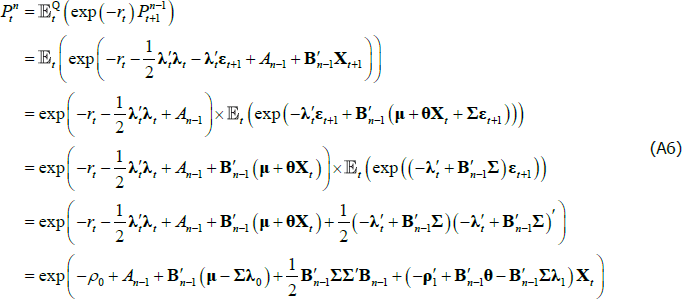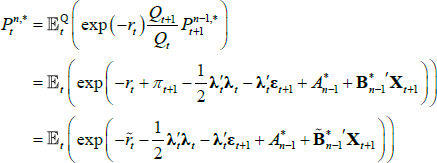RDP 2018-02: Affine Endeavour: Estimating a Joint Model of the Nominal and Real Term Structures of Interest Rates in Australia Appendix A: The Affine Term Structure Model
February 2018
- Download the Paper 1,673KB
This section documents the mathematics of the ATSM that we use, and follows the expository style and terminology of Ang and Piazzesi (2003) closely.
First we derive pricing equations for the general class of ATSM that we use. Let  be the price of a nominal bond at time t that pays one dollar at time t + n. The no-arbitrage assumption implies that an equivalent martingale (or risk-neutral) measure, denoted by Q, exists such that
be the price of a nominal bond at time t that pays one dollar at time t + n. The no-arbitrage assumption implies that an equivalent martingale (or risk-neutral) measure, denoted by Q, exists such that
where rt is the nominal short rate (Harrison and Kreps 1979). Assume that the nominal short rate is given by  , where Xt is a stochastic process that describes all economic and financial factors relevant to bond pricing and which evolves according to
, where Xt is a stochastic process that describes all economic and financial factors relevant to bond pricing and which evolves according to
for μ a vector, θ and ∑ matrices, and εt+1 ~N(0,IN). Now denote the Raydon-Nikodym derivative, which converts the risk-neutral measure to the real-world measure, by ξt + 1; for any random variable Zt + 1,
where  without a superscript is understood to be under the real-world measure. In our case, we assume that the so-called market price of risk is given by
without a superscript is understood to be under the real-world measure. In our case, we assume that the so-called market price of risk is given by
for λ0 a vector and λ1 a matrix, and that the Raydon-Nikodym derivative linking the real-world and risk-neutral measures is given by
Note that  is often referred to as the pricing kernel or stochastic discount factor, which summarises how agents discount pay-offs under different states of the world.
is often referred to as the pricing kernel or stochastic discount factor, which summarises how agents discount pay-offs under different states of the world.
Given the above, we now show by induction that bond prices are exponentially affine in Xt. Assume that  ; we will show that this implies that
; we will show that this implies that  . Starting from Equation (A1),
. Starting from Equation (A1),
where line 2 follows from Equations (A3) and (A5) and the assumption that  , line 3 follows from Equation (A2), line 5 follows from the moment-generating function of a multivariate N(0,IN) random variable, and line 6 follows from Equation (A4) and the assumed functional form of rt. Line 6 has the desired functional form of exp
, line 3 follows from Equation (A2), line 5 follows from the moment-generating function of a multivariate N(0,IN) random variable, and line 6 follows from Equation (A4) and the assumed functional form of rt. Line 6 has the desired functional form of exp , and so by equating coefficients that do and do not depend on Xt we can deduce that
, and so by equating coefficients that do and do not depend on Xt we can deduce that
To start the induction and also provide starting values for the above recursion, note that  , which implies that A0 = 0, B0 = 0. One can also directly calculate
, which implies that A0 = 0, B0 = 0. One can also directly calculate  so that A1 = −ρ0 and B1 = −ρ1.
so that A1 = −ρ0 and B1 = −ρ1.
Next consider an inflation-indexed bond  that pays one unit of consumption good, or Qt + n/Qt units of nominal value, at time t + n. Here Qt is the price level, we define inflation πt by Qt/Qt – 1 = exp(πt), and we assume that
that pays one unit of consumption good, or Qt + n/Qt units of nominal value, at time t + n. Here Qt is the price level, we define inflation πt by Qt/Qt – 1 = exp(πt), and we assume that
for π0 a scalar and π1 a vector. As with the nominal case, start by assuming that  . We will show by induction that this implies that
. We will show by induction that this implies that  . The no-arbitrage condition for an inflation-indexed bond is given by
. The no-arbitrage condition for an inflation-indexed bond is given by
where, using the fact that  , we define
, we define  and
and  . But, given these re-definitions, the last line now matches line 2 from the nominal bond case, so that
. But, given these re-definitions, the last line now matches line 2 from the nominal bond case, so that
To provide starting values for the above recursion, note that  , which implies that
, which implies that  .
.
Two things are worth noting. First, in the pricing equations above, the price of risk parameters λ0 and λ1 are confounded with the factors describing the evolution of Xt, being μ, θ and ∑. As such, a cross-section of bond prices is not enough to fully identify the model. Second, and related to the first point, one would obtain the same pricing equations if one assumed that investors were risk neutral (so that λ0 = 0, λ1 = 0) and  for
for  and
and  .
.









